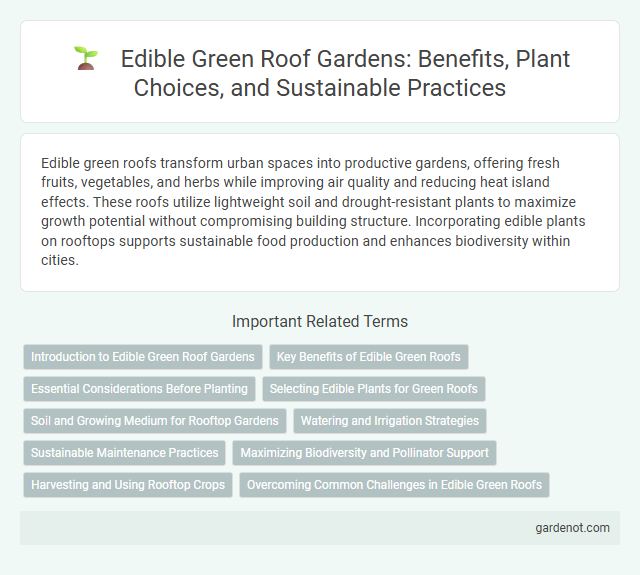Edible green roofs transform urban spaces into productive gardens, offering fresh fruits, vegetables, and herbs while improving air quality and reducing heat island effects. These roofs utilize lightweight soil and drought-resistant plants to maximize growth potential without compromising building structure. Incorporating edible plants on rooftops supports sustainable food production and enhances biodiversity within cities.
Introduction to Edible Green Roof Gardens
Edible green roof gardens transform rooftops into productive spaces by cultivating fruits, vegetables, and herbs, enhancing urban food security and biodiversity. These sustainable structures improve air quality, reduce stormwater runoff, and optimize energy efficiency through natural insulation. Integrating lightweight soil substrates and drought-resistant plants ensures the viability and ecological benefits of edible green roof systems.
Key Benefits of Edible Green Roofs
Edible green roofs enhance urban sustainability by producing fresh fruits, vegetables, and herbs, reducing the carbon footprint associated with food transportation. They improve stormwater management by absorbing rainfall, thus decreasing urban runoff and mitigating flood risks. These roofs also promote biodiversity, support pollinators, and contribute to energy savings through natural insulation.
Essential Considerations Before Planting
Selecting suitable edible plants for a green roof requires analyzing local climate, sunlight exposure, and roof weight capacity to ensure optimal growth and structural safety. Soil depth and quality must be carefully managed to provide adequate nutrients and drainage essential for edible crops. Watering systems and accessibility for maintenance play crucial roles in sustaining plant health and maximizing harvest yields.
Selecting Edible Plants for Green Roofs
Selecting edible plants for green roofs requires prioritizing species with shallow root systems and high drought tolerance, such as herbs like thyme, chives, and oregano, alongside low-growing vegetables like lettuce and spinach. These plants thrive in the limited soil substrate typically found on green roofs, ensuring sustainable growth and maximizing space efficiency. Incorporating native edible plants can enhance biodiversity, support local ecosystems, and reduce maintenance requirements on green roof installations.
Soil and Growing Medium for Rooftop Gardens
Edible roofs require a specially designed soil and growing medium that balances lightweight properties with nutrient retention and drainage to support healthy plant growth. A mix of organic compost, expanded clay aggregates, and lightweight mineral components ensures optimal aeration and moisture levels for rooftop cultivation. Properly engineered substrates enhance root development and sustain edible plants like herbs, vegetables, and fruits in urban green roof systems.
Watering and Irrigation Strategies
Edible green roofs require precise watering and irrigation strategies to maintain plant health and maximize yield. Automated drip irrigation systems tailored to specific crop water needs reduce water waste and promote efficient moisture distribution. Integrating rainwater harvesting and soil moisture sensors further optimizes irrigation, ensuring edible plants receive consistent hydration without overwatering.
Sustainable Maintenance Practices
Edible green roofs incorporate sustainable maintenance practices such as using organic fertilizers and compost to enhance soil fertility while minimizing chemical runoff. Regular monitoring of plant health and water usage supports resource-efficient irrigation systems tailored to crop needs. Integrating native pollinator habitats and natural pest control methods reduces reliance on synthetic pesticides, promoting ecological balance on the roof.
Maximizing Biodiversity and Pollinator Support
Edible roofs enhance urban biodiversity by incorporating diverse plant species that attract and sustain pollinators such as bees, butterflies, and birds. These green roofs provide vital habitats and foraging resources, promoting ecological balance in densely populated areas. Incorporating native and flowering plants ensures continuous nectar supply, maximizing pollinator support and improving overall ecosystem health.
Harvesting and Using Rooftop Crops
Harvesting rooftop crops from edible green roofs requires timing the collection to maximize nutrient content and flavor, often focusing on herbs, leafy greens, and small fruits. Utilizing these fresh ingredients can enhance urban culinary experiences and promote sustainable food consumption by minimizing transportation emissions. Efficient harvesting techniques and proper storage extend the shelf life of rooftop produce, making edible green roofs a viable source of local, pesticide-free food.
Overcoming Common Challenges in Edible Green Roofs
Edible green roofs face challenges such as limited soil depth, water retention, and nutrient management, which can be addressed by using lightweight, nutrient-rich substrates and efficient irrigation systems like drip irrigation. Selecting drought-tolerant, shallow-rooted plants such as herbs and salad greens enhances survival while reducing maintenance. Integrating organic fertilizers and mulch helps maintain soil health and moisture, promoting sustainable growth in rooftop gardens.
Edible roof Infographic

 gardenot.com
gardenot.com